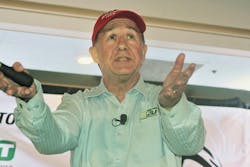During the Tire Industry Association’s (TIA) Off-the-Road Tire Conference held in Oahu, Hawaii, in February, Ron Tatlock, manager of training and engineering for BKT USA Inc., said a dealer can best serve his customers by first helping them make the proper tire selection. This includes the correct tire type with the best load capacity, the best tread depth for the job, and the best construction and compound.
OTR tire dealers also need to perform examinations of their customers’ scrap tires and school them on the importance of correct inflation pressure. Under- or over-loading creates excessive stress and heat that can lead to tire failure, plus it compromises vehicle handling and makes the tires more susceptible to road hazard damage, he said. “A tire that is 20% or more under-inflated is ‘severely under-inflated’ and must be demounted and carefully examined before re-inflating. A dangerous zipper brake is possible,” said Tatlock. “Under-inflation of only 10% can cause up to a 20% loss in tire life.”
Tatlock said dealers must perform regular fleet inspections for their customers, which allows for:
- early detection and resolution of problems,
- extending tire life by maintaining proper inflation pressure and performing properly timed repairs for maximum tire life,
- anticipating tire replacements for inventory control,
- reducing expensive downtime due to tire problems, and
- maximizing tire-related safety.
“You’re not going to sell more tires to the customer if they don’t last as long as the competitors’,” Tatlock said. “Take them out of the tire business. Customers will be less hesitant to pay you if they recognize the value you’re giving them.”
Manufacturer panel
TIA also presented an off-the-road tire manufacturer panel discussion featuring Michael Aguon, associate vice president, OE, technical and national accounts, BKT USA Inc.; Bridget Neal, director, OTR sales, Bridgestone Americas Inc.; Shawn Rasey, director global business development — earthmover tires, Continental Tire the Americas LLC; and Rob Miller, OTR sales zone manager, Yokohama Tire Corp.
When asked what the biggest challenge was for mining customers and mining tires, the experts said:
Neal: Reduced inventory. Many OTR tire customers took tires off idle equipment, and they may be down to one to one-and-a-half months of inventory versus their normal four- to five-month inventory. We encourage our dealers to stay in close communication with their mining customers to avoid shortages.
Miller: Uncertainty in the mining segment. If business does continue to grow, the companies that had taken tires off parked vehicles will now need tires to put equipment to work.
Rasey: Emerging technologies. OTR tire customers are wrestling with the new technology it takes to be more cost effective, safe and get the most from their tires.
Aguon: BKT’s biggest challenge is OTR customers don’t know them. In the ag market, they’re well established. Now BKT needs to promote its brand name in the OTR market.
OTR retreader panel
An OTR retreader panel consisted of Patrick Culiberk, operations manager for Community Tire Retreading; Noah Hickman, president of H&H Industries Inc.; Bert Jameus, retread plant manager, Kal Tire; Brian Hayes, director of manufacturing, Purcell Tire & Rubber Co.; and James John, vice president, Schrader Retreading, a division of Craft Tire Inc.
When asked for their production forecast for the upcoming year, the panelists said they were optimistic due to price increases on new OTR tires. Said Hayes, “There is a tremendous amount of optimism going forward. Increased prices on new tires have given us breathing room. A theme we’ve heard in the industry is ‘We can’t afford to retread because new tire prices are so cheap.’ For OTR retreading, that is changing.”
Jameus added, “We expect to see a 5% to 7% increase. We’ll be focusing on the 25-inch tire segment, the biggest part of our business, which is looking pretty good.”
Jameus also stressed the need for retreaders to offer a tire with a like-new appearance.
Clean 25-inch casings are most in demand, the retreaders said. Hickman noted, “Good quality casings are getting harder to find. Many customers are running tires to destruction.” He added, “Anything larger than 25 inches, say 33, 35 and 49 inches, people understand the value of the casing.” ■




